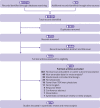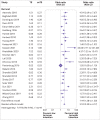Associations of physician burnout with career engagement and quality of patient care: systematic review and meta-analysis
- PMID: 36104064
- PMCID: PMC9472104
- DOI: 10.1136/bmj-2022-070442
Associations of physician burnout with career engagement and quality of patient care: systematic review and meta-analysis
Abstract
Objective: To examine the association of physician burnout with the career engagement and the quality of patient care globally.
Design: Systematic review and meta-analysis.
Data sources: Medline, PsycINFO, Embase, and CINAHL were searched from database inception until May 2021.
Eligibility criteria for selecting studies: Observational studies assessing the association of physician burnout (including a feeling of overwhelming emotional exhaustion, feelings of cynicism and detachment from job defined as depersonalisation, and a sense of ineffectiveness and little personal accomplishment) with career engagement (job satisfaction, career choice regret, turnover intention, career development, and productivity loss) and the quality of patient care (patient safety incidents, low professionalism, and patient satisfaction). Data were double extracted by independent reviewers and checked through contacting all authors, 84 (49%) of 170 of whom confirmed their data. Random-effect models were used to calculate the pooled odds ratio, prediction intervals expressed the amount of heterogeneity, and meta-regressions assessed for potential moderators with significance set using a conservative level of P<0.10.
Results: 4732 articles were identified, of which 170 observational studies of 239 246 physicians were included in the meta-analysis. Overall burnout in physicians was associated with an almost four times decrease in job satisfaction compared with increased job satisfaction (odds ratio 3.79, 95% confidence interval 3.24 to 4.43, I2=97%, k=73 studies, n=146 980 physicians). Career choice regret increased by more than threefold compared with being satisfied with their career choice (3.49, 2.43 to 5.00, I2=97%, k=16, n=33 871). Turnover intention also increased by more than threefold compared with retention (3.10, 2.30 to 4.17, I2=97%, k=25, n=32 271). Productivity had a small but significant effect (1.82, 1.08 to 3.07, I2=83%, k=7, n=9581) and burnout also affected career development from a pooled association of two studies (3.77, 2.77 to 5.14, I2=0%, n=3411). Overall physician burnout doubled patient safety incidents compared with no patient safety incidents (2.04, 1.69 to 2.45, I2=87%, k=35, n=41 059). Low professionalism was twice as likely compared with maintained professionalism (2.33, 1.96 to 2.70, I2=96%, k=40, n=32 321), as was patient dissatisfaction compared with patient satisfaction (2.22, 1.38 to 3.57, I2=75%, k=8, n=1002). Burnout and poorer job satisfaction was greatest in hospital settings (1.88, 0.91 to 3.86, P=0.09), physicians aged 31-50 years (2.41, 1.02 to 5.64, P=0.04), and working in emergency medicine and intensive care (2.16, 0.98 to 4.76, P=0.06); burnout was lowest in general practitioners (0.16, 0.03 to 0.88, P=0.04). However, these associations did not remain significant in the multivariable regressions. Burnout and patient safety incidents were greatest in physicians aged 20-30 years (1.88, 1.07 to 3.29, P=0.03), and people working in emergency medicine (2.10, 1.09 to 3.56, P=0.02). The association of burnout with low professionalism was smallest in physicians older than 50 years (0.36, 0.19 to 0.69, P=0.003) and greatest in physicians still in training or residency (2.27, 1.45 to 3.60, P=0.001), in those who worked in a hospital (2.16, 1.46 to 3.19, P<0.001), specifically in emergency medicine specialty (1.48, 1.01 to 2.34, P=0.042), or situated in a low to middle income country (1.68, 0.94 to 2.97, P=0.08).
Conclusions: This meta-analysis provides compelling evidence that physician burnout is associated with poor function and sustainability of healthcare organisations primarily by contributing to the career disengagement and turnover of physicians and secondarily by reducing the quality of patient care. Healthcare organisations should invest more time and effort in implementing evidence-based strategies to mitigate physician burnout across specialties, and particularly in emergency medicine and for physicians in training or residency.
Systematic review registration: PROSPERO number CRD42021249492.
© Author(s) (or their employer(s)) 2019. Re-use permitted under CC BY-NC. No commercial re-use. See rights and permissions. Published by BMJ.
Conflict of interest statement
Competing interests: All authors have completed the ICMJE uniform disclosure form at www.icmje.org/coi_disclosure.pdf and declare: support from the UK National Institute for Health and Care Research School for Primary Care Research for the submitted work; no financial relationships with any organisations that might have an interest in the submitted work in the previous three years; no other relationships or activities that could appear to have influenced the submitted work.
Figures






Comment in
-
Physician burnout undermines safe healthcare.BMJ. 2022 Sep 14;378:o2157. doi: 10.1136/bmj.o2157. BMJ. 2022. PMID: 36104075 No abstract available.
-
Returning to the core practices of being a doctor to avoid physician burnout.BMJ. 2022 Oct 12;379:o2437. doi: 10.1136/bmj.o2437. BMJ. 2022. PMID: 36223903 No abstract available.
References
-
- Maslach C. Burnout, Psychology of. In: Wright JD, ed. International Encyclopedia of the Social & Behavioral Sciences. 2nd ed. Elsevier, 2015: 929-32 10.1016/B978-0-08-097086-8.26009-1. - DOI
-
- General Medical Council . National Training Survey 2021 results. 2021. https://www.gmc-uk.org/-/media/documents/national-training-survey-result....
Publication types
MeSH terms
LinkOut - more resources
Full Text Sources
